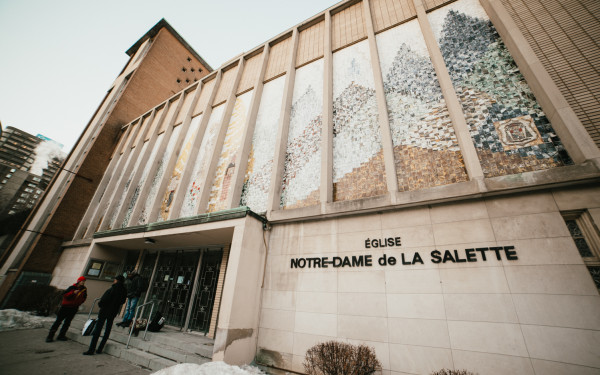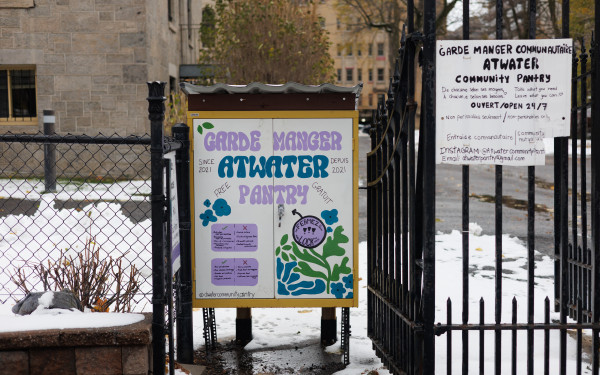A new approach to food security in Montreal
Innovation Assistance is tackling food insecurity with a pay-what-you-can model
Montreal’s grocery stores are full of choices—until you can’t afford them.
But in one small Montreal food market, the rules are different. At Innovation Assistance, food is priced by need, not profit, and no one leaves empty-handed.
Two Mondays per month, Innovation Assistance hosts markets that provide access to beautiful, local, affordable food through a social-tiered pricing system. This means that those who can pay more partially subsidize lower costs for others.
“Food is very expensive these days,” said Edna Do Prado, a participant who now also volunteers at the market. “Unless I come here, I can’t afford vegetables and greens.”
Innovation Assistance started in response to the need in Montreal’s downtown Peter-McGill neighbourhood. In its early years, the program functioned much like a conventional food bank. But when it was forced to relocate due to development plans, the team saw an opportunity to rethink the model.
“We went from giving slightly gross food for no money to people to giving them beautiful food at a low cost,” said program coordinator Micah Angell.
Members pay about 20 per cent of retail price for produce and 50 per cent for essentials like milk and eggs. Those on the waitlist or who can afford to pay a bit more pay closer to 50 per cent of retail price. Others can opt to pay it forward, contributing extra to support the market’s financial independence.
In Quebec, the cost of groceries has climbed over 17 per cent in just three years, according to Statistics Canada’s most recent monthly average retail prices on produce. Staple items have seen dramatic price hikes. The average retail price of a two-litre carton of milk rose from $4.50 in December 2021 to $5.30 in December 2024, marking an increase of approximately 17.8 per cent. Similarly, a 675g loaf of white bread saw its price climb from $2.95 to $3.47 over the same period, reflecting an increase of about 17.6 per cent.
“The poor are having a hard time these days because everything is for the budget of a rich person,” Do Prado said. “It's not for the budget of a poor person, of the average person.”
The solidarity market is just one part of Innovation Assistance’s broader mission. The organization also runs mobile markets for seniors, bringing food directly to low-income housing residences and community kitchens, where people can learn cooking skills while collectively preparing meals from surplus ingredients.
The market additionally provides job and academic opportunities for young adults who haven’t completed high school. Through Innovation Assistance’s encompassing organization, Innovation Youth, the Connections program allows participants to earn academic credits while working at the market, like operating the checkout to develop their math skills.

Daniel Poenaru is the coordinator of the Connections program. He said Innovation Assistance has shifted away from a “tense, antagonistic kind of sense of competition” that can be experienced at typical food banks, where clients often wait in long queues.
The shift is noticeable: People now sit, chat and drink coffee together in the cafe area, rather than rushing in and out. More members have started volunteering, helping others access the market and encouraging new people to join. Some who initially came for assistance are now involved in supporting the program, reinforcing what Poenaru calls a “circular economy.”
“It's become a much more kind of communal, relaxed environment,” Poenaru said.
Innovation Assistance also operates eight community gardens across downtown Montreal, from Atwater to the Visual Arts Building at Concordia University. These gardens, maintained by volunteers and paid interns, provide fresh produce for the market and educational opportunities for local youth.
Even in the winter, the market tries to keep it local, with things like squash, beets and turnips.
“Just [because] you have a hard time buying groceries doesn't mean that you shouldn't have access to beautiful romaine lettuce or butternut squash,” Angell said.
According to Angell, food banks were never meant to be a long-term solution. In Canada, they emerged in the 1980s as a temporary response to economic hardship. Four decades later, they have become permanent fixtures of social policy.
The landscape of food insecurity in Montreal has changed since the early days of the pandemic, when the program began.
“During the pandemic, it was a lot more people that were just in a tough spot, like, ‘Shit, I lost my job. I just need food for right now,’” Angell said. “In the past couple years, it's transitioned more to people that generally are more long-standing in need of help.”
For Angell, ideally, emergency food assistance is meant to provide temporary relief, helping people get through a tough time to a better stage in life. But in the past few years, she said, more of those seeking help now are on welfare due to disabilities or chronic conditions that make employment difficult, or they struggle with financial management, which can perpetuate cycles of poverty.
International students are another significant demographic, particularly since the program relocated closer to Concordia’s downtown campus. Angell estimates that 30 to 35 per cent of the people who come to the market are students.
According to the Food Banks of Quebec, in 2024, 87 per cent of food bank users in the province were tenants, and 10.5 per cent were students. The number of students relying on food banks has surged from 6,619 in 2019 to 16,652 in 2024—an increase of nearly 10,000 people in just five years.
Angell believes government action is needed to address the root causes of food insecurity. According to her, rent hikes, precarious employment and the monopolization of the grocery sector are all contributing factors.
“If you are housing insecure, then you will likely be food insecure; if you’re job insecure, then you will likely be food insecure,” Angell said. “Often, being food secure or eating healthy food is something that just falls to the wayside because it is a little bit lower priority [than having a roof over your head].”
The tiered pricing model is part of a broader shift in how food security is approached in Montreal. Similar initiatives exist elsewhere—such as Carrefour Solidaire, a grocery store in the Sainte-Marie area where customers select their own pricing tier—but the concept remains relatively rare.
“Most people are passionate about food in some way,” Angell said. “How can we build community around that?”
This article originally appeared in Volume 45, Issue 10, published March 4, 2025.


_600_832_s.png)




